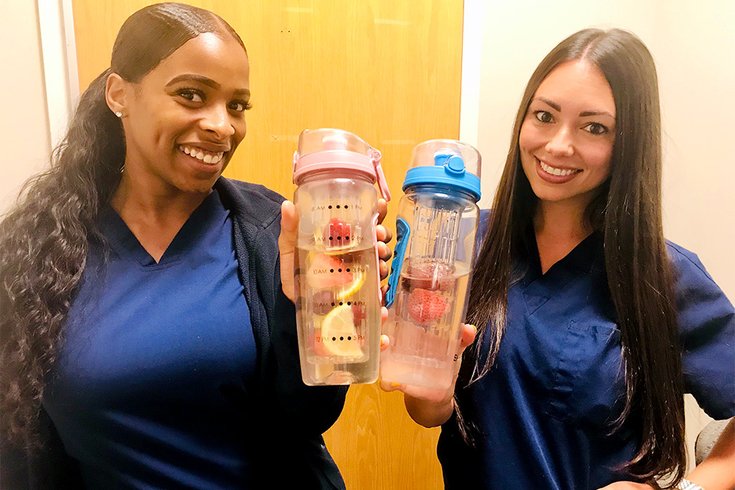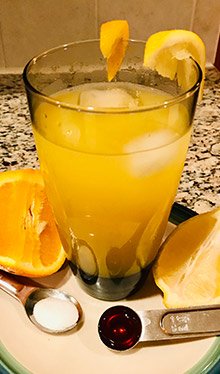
July 23, 2019
 Photo courtesy/Emily Rubin
Photo courtesy/Emily Rubin
Markisha Thomas, left, and Cody Finkelberg, employees with Jefferson's Division of Gastroenterology, infuse fruits like strawberries, lemons and grapes in their water to stay hydrated and energized throughout the day.
Before you read any further, I need you to get a cup of water. By the time you feel thirsty, chances are you are already slightly dehydrated and may have already lost about 1 percent of your body’s water level.
The recommendation of eight glasses of water per day is age-old advice, but your daily water requirement is unique to your day-to-day activities. Your body is made up of 60 percent water. It not only helps to regulate body temperature — especially important on these long, hot summer days — but it also transports nutrients like carbohydrates, fats, proteins and vitamins to your organs.
The National Academies of Sciences, Engineering, and Medicine determines general fluid guidelines, which calls for men to get about 15.5 cups (121 ounces) of total fluids and women to get about 11.5 cups (92 ounces) of total fluids a day. About 20 percent of your daily fluid intake usually comes from food and the rest from drinks. That translates to 13 cups of water for men and nine cups per day for women.
I prefer a more individual approach to determine daily fluid requirements based on your body weight. The basic equation for determining this is by dividing your body weight in half.
| Body weight | Daily fluid requirements (approximate) |
| 100 pounds | 50 ounces |
| 150 pounds | 75 ounces |
| 200 pounds | 100 ounces |
There are other factors to consider when monitoring your hydration levels. Every time you breathe, use the bathroom and work out, you are losing water. That morning cup of coffee? Diuretics like coffee and other caffeinated drinks may trick your body that it is hydrated. Since coffee has the highest amount of caffeine, for every cup you drink, drink one glass of water. Same goes for alcoholic drinks.
Active individuals require more water than sedentary. If you exercise, drink another eight ounces of water for every 20 minutes you are active. If you are intensely working out for more than 60 minutes, you will probably need to replace electrolytes by adding a sports or electrolyte-enhanced drink, which contains additional minerals like sodium, chloride, potassium, magnesium and calcium. Coconut water is another great hydrating option that has as much potassium as a banana. Be sure to find my recipe for a homemade sports drink below!

Emily Rubin, R.D.
Summertime is a popular time for traveling. If you happen to be traveling by plane, do not forget your refillable water bottle. At high altitude, your body loses fluids faster because you are breathing more rapidly due to fluctuating oxygen and humidity levels on the aircraft. Drink eight ounces of water for every hour onboard. If you happen to be landing in a high-altitude level, like Colorado, drink an additional two cups of water daily.
If you don’t like the taste of water, my advice here is to try infusing it with fruits like lemon and strawberry or cucumber and mint. You can even freeze fruit in ice cube trays to add to your water throughout the day. You can also add flavor drops or powdered flavors to your water, which typically have no calories and come in a wide selection of flavors from blueberry to strawberry lemonade.
Remember that foods can help fill those large fluid requirements each day. Watermelon is 92 percent water, making it one of the most hydrating foods, as a one-cup serving contains more than half a cup of water. Other high-water-content foods are celery, spinach, cucumbers and berries.
 Photo courtesy/Emily Rubin
Photo courtesy/Emily RubinEmily Rubin's recipe for a hydrating sports drink has an orange-lemon kick.
Ingredients:
2.5 cups water
1 cup orange juice
½ cup lemon juice
2 tbsp honey or sugar
½ tsp salt
Instructions:
Add ingredients to blender and mix well. Enjoy chilled or over ice.
Emily Rubin, R.D., has been a registered dietitian with Thomas Jefferson’s division of gastroenterology and hepatology for 18 years. She is the dietitian for its celiac center, Fatty Liver Center and Weight Management Center. She is also the public relations chair for the Philadelphia Dietetic Association. She will be writing occasionally on topics related to nutrition and dieting.